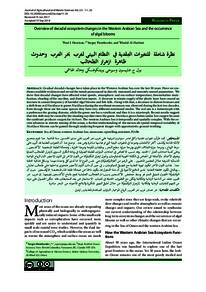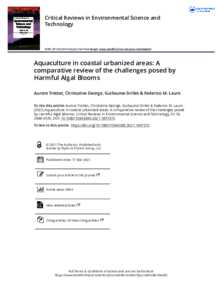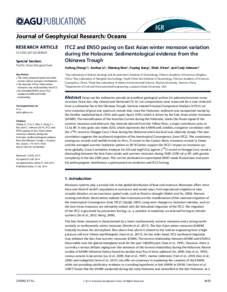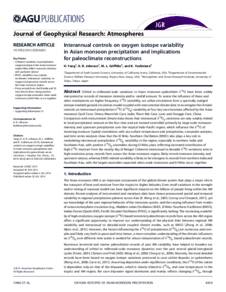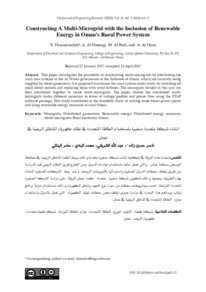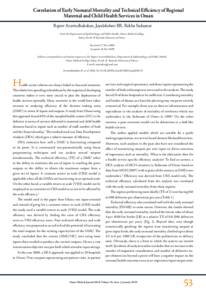وثيقة
Overview of decadal ecosystem changes in the Western Arabian Sea and the occurrence of algal blooms.
المساهمون
Piontkovski, Sergey., مؤلف
Al-Hashmi, Khalid., مؤلف
الناشر
جامعة السلطان قابوس. كلية العلوم الزراعية والبحرية
ميلادي
2018
اللغة
الأنجليزية
الملخص الإنجليزي
Gradual decadal changes have taken place in the Western Arabian Sea over the last 50 years. Here we syntheses available evidences and reveal the trends pronounced in directly measured and remotely sensed parameters. We show that decadal changes have affected wind speeds, atmospheric and sea surface temperature, thermohaline stratification, shoaling of the oxycline, and dust/iron inputs. A decrease in nitrate supply of the photic layer have caused an increase in annual frequency of harmful algal blooms and fish kills. Along with that, a decrease in diatom biomass and a shift from red Noctiluca to green Noctiluca during the northeast monsoon was observed during the last two decades, Even though these are the same species they have very different nutritional modes. The red one is a heterotroph with a preference for grazing diatoms, while the green one has a symbiont and thus it is a mixotroph. Recent results suggest that this shift may be caused by the shoaling oxycline since the green Noctiluca grows better under low oxygen because the symbiont produces oxygen for its host. The western Arabian Sea is temporally and spatially complex. With the recent advances in remote sensing of the ocean, a further understanding of the mesoscale spatial-temporal variability of Noctiluca blooms can be gained through analyzing frequent images with opportunistic ground-truthing.
المجموعة
ISSN
2410-1079
URL المصدر
zcustom_txt_2
Harrison, P. J., Piontkovski, S., & Al-Hashmi, K. (2018). Overview of decadal ecosystem changes in the Western Arabian Sea and the occurrence of algal blooms. Agricultural and Marian Sciences Journal, 23 (1), 11-23.
الملخص العربي
لقد طرأت تغيرات عقدية (كل عشر سنوات) تدريجية على غرب بحر العرب على مدى الخمسين سنة الماضية. هنا نقوم بتجميع الأدلة المتاحة وكشف أكثر الاتجاهات وضوحا في المتغيرات البيئية التي تم قياسها مباشرة وعن بعد. نوضح هنا أن التغيرات العقدية قد أثرت على سرعة الرياح، ودرجة حرارة الغلاف الجوي ودرجة حرارة سطح البحر، وطبقات الملوحة ودرجة الحرارة، وضحالة الطبقة المنخفضة الأكسجين، وعلى كمية إمدادات الغبار/ الحديد. وقد تسبب الانخفاض في إمدادات النيترات للطبقة الضوئية في زيادة التكرار السنوي لازهرار الطحالب الضارة ونفوق الأسماك. بالإضافة إلى انخفاض في الكتلة الحيوية للداياتومات وتحول ازهرار النكتيلوكا من اللون الأحمر إلى اللون الأخضر أثناء الرياح الموسمية الشمالية الشرقية خلال العقدين الماضيين. على الرغم من أنها (النوكتيلوكا) هي نفس النوع إلا أن لدى كل واحدة منهما وسائل غذائية مختلفة جدا. فذات اللون الأحمر تكون غيرية التغذية مع تفضيل الدياتومات، في حين أن ذات اللون الأخضر فتحتوي بداخلها على طحالب تعايش، وبالتالي تكون مختلطة التغذية. تشير النتائج الأخيرة إلى أن هذا التحول قد يكون ناجمًا عن ضحالة طبقة الماء المنخفضة الأكسجين حيث أن النوكتيلوكا الخضراء تفضل النمو في وسط منخفض الأكسجين بسبب أن الطحالب التعايشية تقوم بإنتاج الأكسجين لمضيفها. إن غرب بحر العرب معقد من الناحية الزمانية والمكانية ولكن مع التطورات الحديثة في تقنيات الاستشعار عن بعد للمحيطات فإنه يمكن الحصول على مزيد من الفهم للتقلبات الزمانية والمكانية لازهرار النوكتيلوكا من خلال تحليل الصور المتكررة والنتائج المأخوذة من البحر مباشرة.
قالب العنصر
مقالات الدوريات

